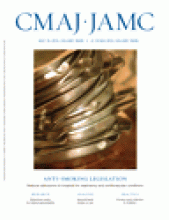The Canadian government must do more to increase representation in medical schools of people from rural areas and low socio-economic groups, according to the Canadian Federation of Medical Students.
Inadequate representation of Canadian medical students from rural and low socioeconomic backgrounds is exacerbating Canada’s family physician shortage and reducing accessibility to health care in rural and low-income communities, says Tyler Johnston, president of the federation, which undertook an all-day lobby of federal politicians on Mar. 29 in hopes of persuading the government to do more to make medical school populations more representative of the general population.
“There is evidence now that suggests that students from rural backgrounds are two-and-a-half times more likely to practise in rural areas, and students from low socioeconomic status are more likely to practise in areas of low socio-economic status,” says Johnston. “There is even some evidence that members from both groups are more likely to practise family medicine.”
The government should set medical school admission targets to improve the representation of students coming from rural areas or low socio-economic groups, says Dr. Karl Stobbe, president of the Society of Rural Physicians of Canada.
Canadian medical schools tend to admit mostly “smart, rich kids,” says Stobbe. But the government could increase the number of medical students from rural or low-income areas by setting admission targets for people from such backgrounds and hold “universities accountable to them.”
“Universities will find different ways to achieve the targets,” he adds.
Medical school has become the purview of the privileged in Canada, says Dr. Karl Stobbe, president of the Society of Rural Physicians of Canada. Image courtesy of Niagara Health System
The fact that most Canadian medical students are well-off city dwellers has long been a concern. In 2002, an analysis of medical school enrolments found that only 10.8% of first-year students came from rural areas, where 22.4% of Canadians lived (CMAJ 2002;166:1029–35).
In addition, 17% of parents of medical students had household incomes greater than $160 000, although just 2.7% of Canadian households had incomes higher than $150 000. Roughly 15.4% of parents of medical students had annual household incomes less than $40 000 in 2002, although the income group represented 39.7% of Canadian households. Parents of medical students were also found to be much more likely than other Canadians in their age range to have graduate degrees and jobs as professionals or high-level managers.
That data differed little from the numbers recorded in the mid-1960s. Rural students in the 2002 study were only slightly better represented than in the 1965/66 academic year, when 8.4% of medical students had rural backgrounds, compared to 30.4% of the overall population.
“That the magnitude of the socio-economic difference between medical students and the general Canadian population has changed so little must be viewed as disappointing,” the study stated. “For example, the widely held belief that children of doctors are over-represented among medical students is truer today than 35 years ago: 15.6% of today’s medical students have a physician parent, as compared with 11.8% in 1965/66.”
One possible reason for the low number of rural-origin medical students is that medical schools tend to be in heavily populated urban centres, which may be intimidating to students from smaller communities. According to a 2005 analysis of 2052 applicants to the University of Toronto’s medical school, only 4.5% were from rural areas (Open Med 2007 Apr 14;1(1):e13–7). Rural applicants were, however, just as likely as urban applicants to be offered admissions. But rural applicants were more than twice as likely to decline an admission offer.
“Programs to increase physician supply in rural areas need to address students’ concealed preferences that are established before enrolment,” the authors stated. “Medical schools, in particular, need to encourage more rural students to apply and to persuade those offered admission to accept.”
Several organizations in addition to the Canadian Federation of Medical Students have called attention to this problem.
The Association of Faculties of Medicine of Canada recommended in a 2009 report, The Future of Medical Education in Canada (FMEC): A Collective Vision for MD Education, that medical school admission requirements be changed to promote greater diversity (www.afmc.ca/fmec/pdf/collective_vision.pdf). “Evidence is mounting that today’s medical students increasingly hail from the highest income-earning families in Canada,” the paper states. “Parallel to this, little progress has been made in attracting applicants from First Nations, Inuit, and Métis communities and rural areas.”
The Society of Rural Physicians argued in 2004 that strategies to boost the number of rural-origin students fall into three categories: education initiatives, such as high school outreach programs, health-related summer programs for high school students, pre-med mentoring and support systems for rural university students; funding support, such as scholarships, tuition relief and need-based bursaries; and admission process changes, such as the inclusion of rural physicians on admission committees and rural admission targets (www.srpc.ca/librarydocs/Admissions_SRPC.PDF).
Stobbe says it would be a challenge for medical schools to achieve targets that would result in the admission of more students from rural areas or low-income groups.
But it is possible, he adds, pointing to Australia as an example. In 1989, only 10% of medical students in Australia were from rural areas. To boost that percentage, the Australian government began offering financial incentives and by 2000, roughly 25% of medical students had rural backgrounds.
Footnotes
-
Published at www.cmaj.ca on Apr. 1









